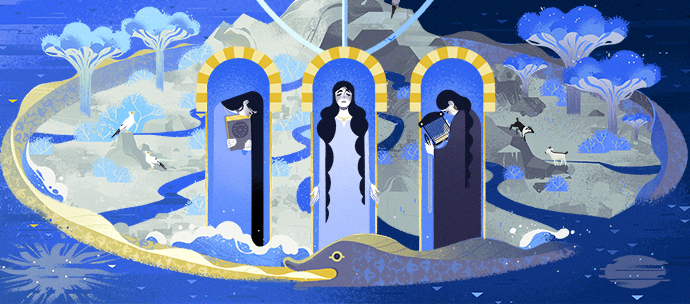Welcome back, dear stellar being!
The year is almost at an end, blessed be the new one, that is already on the horizon!
After we set the scene together last time with an introduction to the island of Dioscoria (if you missed the issue, here’s a link to the archive), this edition of The Reminiscence will be all about its biggest attraction and the reason you are here: Sefirot.
The game itself is said to be as old as Dioscoria itself and its rules have seen many evolutions since. Like many popular games, house rules are widespread and encouraged.
The typical Dioscorian is rather communal and likes to play with others, something Sefirot facilitates with multiple two-player rule sets. But Sefirot is also often enjoyed alone and there is a simple explanation for this. Sefirot is more than a simple game. It holds great potential for divination.
To play, you need a dedicated board, of which there are two variants. One for a single person and one for double divination. Be it a specially prepared table, a finely crafted wooden board or one of the many custom cloth maps sold in the bazaars of Dioscoria, the choice is yours. Additionally you will also be using a full tarot deck.
In both versions a player takes three cards in their hand initially and starts taking a card per turn from the shuffled talon. Major arcana have to be laid on segment of the board, minor arcana on a separate section in a grid. Once cards on this grid add up to 10, 20 or 30 in column or row, they must be transferred to the area of the major arcana to match their numerical values. When a major arcanum is equally matched, it counts as fulfilled.
In the solitaire version the player fills up an entire tree of life, also known as a Sefirot, from the bottom up with fulfilled major arcana. Up to two neighboring major arcana can be combined in their numerical values. The game is lost when there is no more space to lay down minor arcana that were to be moved from the grid. Depending on the chosen difficulty up to four cards can be transferred to separate “grace fields” to save the player. This version of the game is called “Know Thyself”.
In the two player version, players seek to control a field of planets, interconnected in a space not dissimilar to the tree of life. Starting from their side of the board, they move into this star field, trying to occupy it with their major arcana. Fulfilled cards and fields count as taken, while one can take over unfulfilled cards of the enemy. Face cards can be used as defence mechanisms that have to be met with the equal value of 10 or the same rank in order to break that defence. The game is over once all cards are spent or a player forfeits. The player with the most occupied fields and the highest combined amount of card values wins. This version of the game is called “Warring Worlds”.
But why fight? Why not explore the universe together? There is another two player version, where players cooperate. They move towards each other, combine their cards and hope to fullfill all the cards together. Their fates become intertwined. This version of the game is called “A Lovers’ Discourse”.
Now, this was just a very brief introduction, lacking the advanced rules and details. You can find some videos of the solitaire game in action here (Twitter) or here (Instagram).
Come 2021, we’ll be making weekly streams of the game to present materials and also show you the various game modes in action.
If you’re still left with questions regarding the basic rules, or are inspired and want to share ideas for the rules, you’re more than welcome to join our Discord server to talk with the team and fellow diviners. And even if everything is clear, I am very much looking forward to meeting you there!
In the meantime, may you transition well through the midwinter nights,
Georg, Card Master







